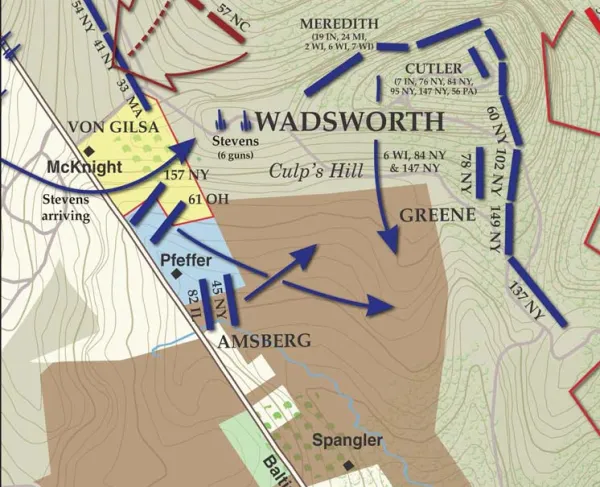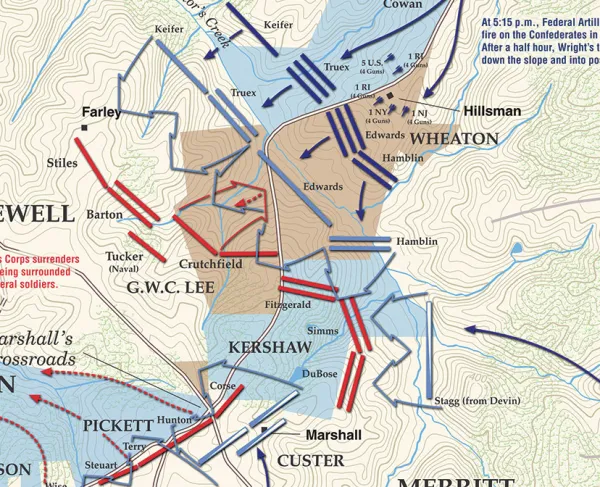
Save Central Land at 3 Battlefields Including Gettysburg
They say “good things come in small packages.” Today, we have the opportunity to save three small, but vital tracts of land and pay honor to a local preservation hero. Each of these tracts is near the center of each battlefield and are therefore extremely important to preserve if we possibly can.
Gettysburg, Pennsylvania
On the slopes of East Cemetery Hill, abutting the Baltimore Pike and sitting just below the crest of the Union artillery position on Stevens Knoll, this half-acre tract figured prominently in the second day of the Battle of Gettysburg — it’s a key missing piece of East Cemetery Hill. The land above it to the east (McKnight’s Hill or Stevens Knoll) was among the first tracts preserved at Gettysburg. Tens of thousands of Union troops marched right in front of, paused on, or passed over, the tract on July 1 and 2, 1863. On July 1, as the Union met disaster north and west of Gettysburg, Northern troops fell back to and fortified Cemetery Hill.
Union General Winfield Scott Hancock ordered Captain Greenleaf Stevens’ 5th Maine Battery to occupy McKnight’s Hill. Stevens shouted, “Fifth Battery, forward,” as he led the battery to James McKnight’s house, turned left down McKnight’s lane, and moved around McKnight’s stone walls to get into position atop the hill.
July 2 saw roughly one-third of the Union army marching past this tract. Later that day Union Eleventh Corps soldiers marched directly across the tract en route to defensive positions on the nearby Culp’s Hill.
In the last decade, the National Park Service has restored the historic wood line around Stevens’ Knoll, and Trust supporters preserved the adjacent tract to the south, making the current tract even more visible and important. And today, it is currently zoned for commercial use. A hotel has already been constructed across the Baltimore Pike. If we don’t save this tract now, it would not be a surprise if it was developed into a commercial enterprise.
Parker’s Cross Roads, Tennessee
In early November 1862, Ulysses S. Grant launched a campaign to capture Vicksburg. By the middle of the following month, Grant’s supply line extended from Mississippi to Kentucky. Hoping to disrupt Grant’s logistics, Gen. Braxton Bragg dispatched Brig. Gen. Nathan Bedford Forrest’s cavalry into West Tennessee. On the morning of December 31, Forrest encountered elements of Col. Cyrus Dunham’s brigade near Parker’s Cross Roads.
In a fight that gave new meaning to the phrase “chaos of battle” Union and Confederate forces fought back and forth across this land. Later in the day, Col. John Fuller’s brigade arrived to reinforce Dunham, and one of Fuller’s regiments, the 39th Ohio, advanced south over the tract and engaged Forrest. Fighting on two fronts, Forrest managed to disengage and withdraw.
Acquisition of this land, adjacent to a 51-acre tract we previously preserved, would continue our decades-long effort to preserve the Parker’s Cross Roads battlefield. If we do not save this land now, the threat is that someone could come in, purchase this house and half-acre of land, tear down the older house and put up a new gas station or mini-mart, right in the middle of the battlefield that you and I have worked so hard to preserve.
Sailor’s Creek, Virginia
A glance at the battle map shows the important history that happened on this small tract. On April 6, 1865, only about 72 hours before the surrender at Appomattox, Lee’s Confederates under generals Richard Anderson, George E. Pickett and Bushrod Johnson aligned their troops near the strategically important Marshall’s Crossroads to receive the onslaught of pursuing Federal cavalry led by General Wesley Merritt.
His divisions, led by generals George A. Custer, Thomas Devin and George Crook, pounded the weakened Confederates in brief but fierce fighting, eventually scattering them back toward Rice’s Depot and the portion of Lee’s army that remained. Seeing this retreat from a nearby overlook, the commanding general remarked, “My God! Has the army dissolved?” It’s a small tract of land, but it would be a major preservation victory to save it forever.
This land acquisition is made possible by a local preservation hero, Chris Calkins, who is preserving and restoring the property with our help.
In each of these three cases, we have saved larger tracts of land nearby. Now, we must painstakingly add the smaller “puzzle pieces” to help complete and protect these battlefields from the bad things that could happen to them.
The good news is that – through a combination of federal and state grants and a landowner donation – we can save these three “small packages” which would cost $765,000 if we had to pay full price… for just $193,000.


